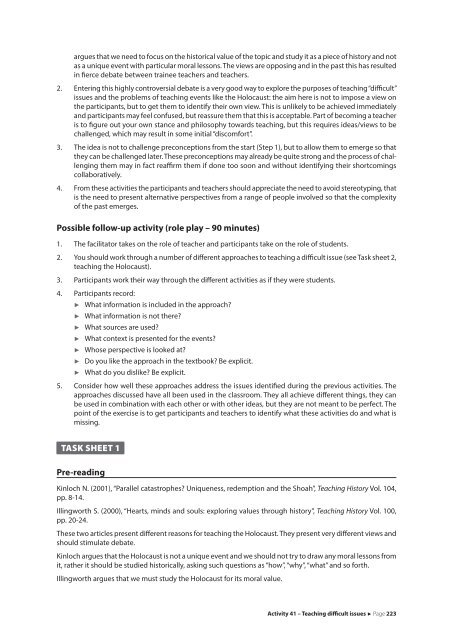TASKs for democracy
4NYw4W
4NYw4W
Create successful ePaper yourself
Turn your PDF publications into a flip-book with our unique Google optimized e-Paper software.
argues that we need to focus on the historical value of the topic and study it as a piece of history and not<br />
as a unique event with particular moral lessons. The views are opposing and in the past this has resulted<br />
in fierce debate between trainee teachers and teachers.<br />
2. Entering this highly controversial debate is a very good way to explore the purposes of teaching “difficult”<br />
issues and the problems of teaching events like the Holocaust: the aim here is not to impose a view on<br />
the participants, but to get them to identify their own view. This is unlikely to be achieved immediately<br />
and participants may feel confused, but reassure them that this is acceptable. Part of becoming a teacher<br />
is to figure out your own stance and philosophy towards teaching, but this requires ideas/views to be<br />
challenged, which may result in some initial “discom<strong>for</strong>t”.<br />
3. The idea is not to challenge preconceptions from the start (Step 1), but to allow them to emerge so that<br />
they can be challenged later. These preconceptions may already be quite strong and the process of challenging<br />
them may in fact reaffirm them if done too soon and without identifying their shortcomings<br />
collaboratively.<br />
4. From these activities the participants and teachers should appreciate the need to avoid stereotyping, that<br />
is the need to present alternative perspectives from a range of people involved so that the complexity<br />
of the past emerges.<br />
Possible follow-up activity (role play – 90 minutes)<br />
1. The facilitator takes on the role of teacher and participants take on the role of students.<br />
2. You should work through a number of different approaches to teaching a difficult issue (see Task sheet 2,<br />
teaching the Holocaust).<br />
3. Participants work their way through the different activities as if they were students.<br />
4. Participants record:<br />
<br />
<br />
<br />
<br />
<br />
<br />
<br />
What in<strong>for</strong>mation is included in the approach?<br />
What in<strong>for</strong>mation is not there?<br />
What sources are used?<br />
What context is presented <strong>for</strong> the events?<br />
Whose perspective is looked at?<br />
Do you like the approach in the textbook? Be explicit.<br />
What do you dislike? Be explicit.<br />
5. Consider how well these approaches address the issues identified during the previous activities. The<br />
approaches discussed have all been used in the classroom. They all achieve different things, they can<br />
be used in combination with each other or with other ideas, but they are not meant to be perfect. The<br />
point of the exercise is to get participants and teachers to identify what these activities do and what is<br />
missing.<br />
TASK SHEET 1<br />
Pre-reading<br />
Kinloch N. (2001), “Parallel catastrophes? Uniqueness, redemption and the Shoah”, Teaching History Vol. 104,<br />
pp. 8-14.<br />
Illingworth S. (2000), “Hearts, minds and souls: exploring values through history”, Teaching History Vol. 100,<br />
pp. 20-24.<br />
These two articles present different reasons <strong>for</strong> teaching the Holocaust. They present very different views and<br />
should stimulate debate.<br />
Kinloch argues that the Holocaust is not a unique event and we should not try to draw any moral lessons from<br />
it, rather it should be studied historically, asking such questions as “how”, “why”, “what” and so <strong>for</strong>th.<br />
Illingworth argues that we must study the Holocaust <strong>for</strong> its moral value.<br />
Activity 41 – Teaching difficult issues Page 223


